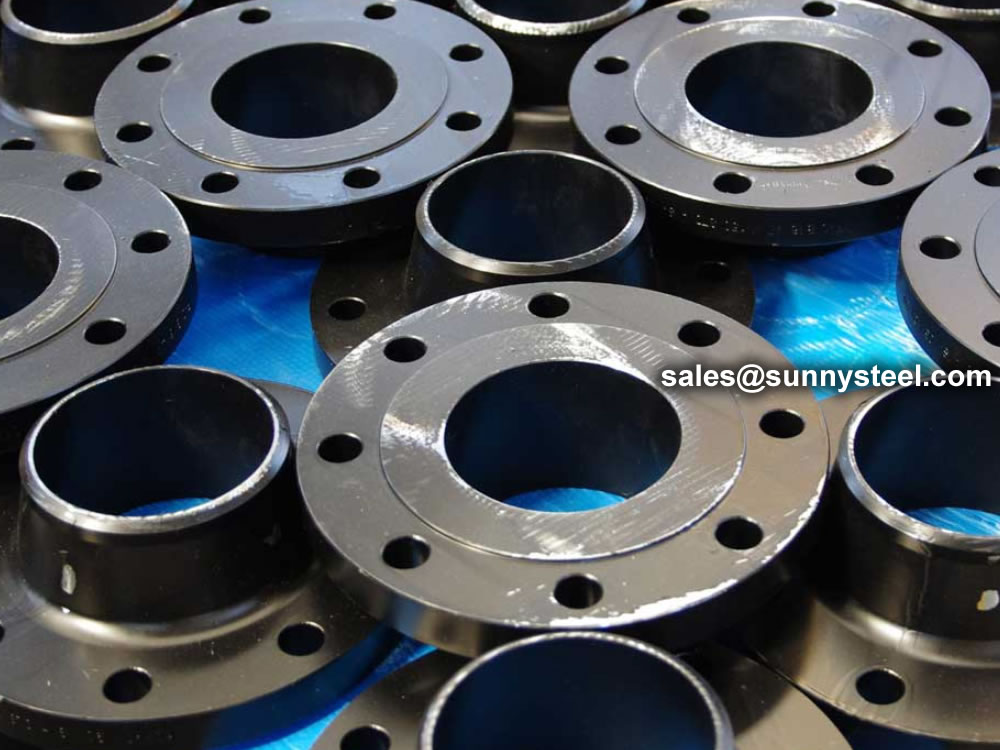Blind Flanges
A blind flange (also called a 'closure plate flange') is installed at the end of a piping system to terminate a pipe.

ASTM A105/A105M Standard Specification for Carbon Steel Forgings for Piping Applications.
Download PDFASTM A105 steel grade is a typical common material (mild carbon steel) for forged carbon steel flange, it used in a lot of places for ambient and higher-temperature service in pressure systems. This material is durable, cost lower, and difficult to break. In case used in a stainless steel piping system it shall be adapted with a lap joint end ring.
ASTM A105 covers forged carbon steel flange and piping components for ambient and higher-temperature service in pressure systems. It also includes pipe fittings, valves and similar parts. The maximum weight manufactured forging part follows by this standard is 10000 bounds (4540kg). The larger forgings can according by the standard A 266/A266M. This specification do not covers tube sheets and hollow cylindrical forgings for pressure vessel shells .
This specification does not covers raw material which round bar and seamless tubular produced piping components.
The following list of standard apply to these specification:
ASTM standards:
MSS standard:
ASME Standard:
API standard:
| Element | Composition, % |
|---|---|
| Carbon | 0.35 max |
| Manganese | 0.60-1.05 |
| Phosphorus | 0.035 max |
| Sulfur | 0.040 max |
| Silicon | 0.10-0.35 |
| Copper | 0.40 max (1) |
| Nickel | 0.40 max (1) |
| Chromium | 0.30 max (1-2) |
| Molybdenum | 0.12 max (1-2) |
| Vanadium | 0.08 max |
| Property | Value |
|---|---|
| Tensile Strength, min (MPa) | 485 (70 ksi) |
| Yield Strength, min (MPa) | 250 (36 ksi) |
| Elongation (%) | 22% |
| Reduction of Area (%) | 30% |
| Hardness (HB) | 187 max |
(1) The sum of copper, nickel, chromium, molybdenum and vanadium shall not exceed 1.00%.
(2) The sum of chromium and molybdenum shall not exceed 0.32%.
Note..
For each reduction of 0.01% below the specified carbon maximum (0.35%), an increase of 0.06% manganese above the specified maximum (1.05%) will be permitted up to a maximum of 1.35%.
Terminology
For definitions of other terms used in this specification, find in specification A961/A961M.
Ordering information
See specification A961/A961M.
General requirements
If conflict between the requirements of this specification and Specification A961/A961M. Comply with this specification.
Heat treatment
Heat treatment is not required except for flanges above Class 300, flanges of special design where the design pressure or design temperature are not known and for items over 4″ NPS and above Class 300. When heat treatment is required, annealing, normalizing, Normalize and temper, normalize and quench and tempering shall be the applied methods.
Welding
These components can be welded. Welding procedures must comply with ASME Boiler and Pressure Vessel Code Section IX.
Forging
ASTM A105 carbon steel can be forged at temperatures in the range of 2200 to 1700 F followed by quenching and tempering or normalizing.
Annealing
Forged parts can be cooled to below 1000 degrees Fahrenheit and then heated to between 1550 degrees Fahrenheit and 1,700 degrees Fahrenheit. Then carry out slow furnace cooling.
Hydro-static Test
Hydro-static Test shall be conducted by the forging manufacture only when Supplemental S57 of ASTM A961 is specified.
ASTM A105 Flange is a specification of flanges. The specification can include different grades of stainless steel material made flanges. The flanges are of forged carbon steel and are meant for high temperature services. Navstar Steel is a leading manufacturer and supplier of the ASTM A105 Flange types.
ASTM A105 Flange is a forged carbon steel piping component designed for use in pressure systems at high temperatures. These flanges are widely used in industries like petrochemical, oil & gas, and power generation.
ASTM A105 flanges are versatile and essential components for high-pressure systems in industries like petrochemical, oil & gas, and power generation. With their carbon steel construction, they offer excellent mechanical properties, making them suitable for high-temperature and high-pressure environments. These flanges are available in multiple configurations, providing reliable and cost-effective solutions for industrial applications.
